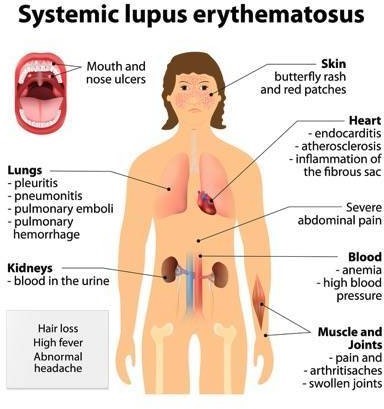A nurse in a provider's office is reinforcing teaching about skin care with a client who has a new diagnosis of systemic lupus erythematosus. Which of the following statements by the client indicates an understanding of the teaching?
"I will use an astringent on my face."
"I will cleanse my skin using an antibacterial soap."
"I will dry my skin by patting it with a towel."
"I will limit my time in the tanning bed to 15 minutes."
The Correct Answer is C
Systemic lupus erythematosus (SLE) is an autoimmune disease that can affect the skin. Proper skin care is important for individuals with SLE to minimize potential flare-ups or exacerbation of skin symptoms. The recommended approach to skin care in SLE includes gentle cleansing and moisturizing.
"I will use an astringent on my face." Astringents are typically not recommended for individuals with SLE as they can be harsh on the skin and may cause irritation or dryness.
"I will cleanse my skin using an antibacterial soap." While it is important to keep the skin clean, using an antibacterial soap is not specifically required for individuals with SLE. Gentle,
Non-irritating cleansers without antibacterial properties are generally recommended.
"I will limit my time in the tanning bed to 15 minutes." Exposure to ultraviolet (UV) radiation, such as from tanning beds, can be particularly harmful to individuals with SLE. UV radiation can trigger or worsen skin manifestations and may lead to disease flares. Therefore, it is generally advised for individuals with SLE to avoid tanning beds altogether.
In addition to gentle cleansing and moisturizing, individuals with SLE should also practice sun protection, including wearing sunscreen with a high sun protection factor (SPF) and using protective clothing and accessories (such as hats and sunglasses) when exposed to the sun. Regular check-ups with a healthcare provider and following their recommendations are important for managing SLE and its associated skin manifestations.

Nursing Test Bank
Naxlex Comprehensive Predictor Exams
Related Questions
Correct Answer is B
Explanation
During an intravenous pyelogram (IVP), a contrast dye is injected into the client's veins, and X-ray images are taken to visualize the urinary tract. The dye used in an IVP can cause a warming or flushing sensation as it circulates through the body. The client's statement indicates an understanding of this common sensation associated with the procedure.
A. "I can have a meal up to 2 hours before the procedure": This statement is incorrect. Typically, for an IVP, the client is required to have an empty stomach before the procedure to ensure accurate imaging results. The client should follow the specific instructions provided by their healthcare provider regarding fasting before the procedure.
C. "I do not need to sign a consent form before this procedure": This statement is incorrect. Informed consent is required for most medical procedures, including an IVP. The client should sign a consent form after receiving all the necessary information about the procedure, its risks, and benefits.
D. "I should limit my fluid intake for 2 days after the procedure": This statement is incorrect. After an IVP, it is generally advised to increase fluid intake to help flush out the contrast dye from the body and prevent potential complications. The client should follow the specific instructions provided by their healthcare provider regarding post-procedure fluid intake.
Correct Answer is D
Explanation
The nurse should intervene when the AP raises all four side rails on the client's bed. While it is important to ensure the client's safety and minimize the risk of falls, raising all four side rails can be considered a restraint and may not be the best practice for fall prevention. The use of physical restraints, including all four side rails, can lead to adverse outcomes such as entrapment, increased agitation, and decreased mobility.
A. Locking the wheels on the client's bed: This is an appropriate action to prevent the bed from rolling and ensure stability.
B. Clearing furniture from the path leading to the bathroom: This is a good practice as it creates a clear and safe path for the client to walk without obstacles.
C. Assisting the client to the bathroom every 2 hours: This is a proactive measure to prevent falls by ensuring regular toileting and minimizing the need for the client to get up and move independently.
It's important to promote mobility and independence for the client while ensuring their safety.
Whether you are a student looking to ace your exams or a practicing nurse seeking to enhance your expertise , our nursing education contents will empower you with the confidence and competence to make a difference in the lives of patients and become a respected leader in the healthcare field.
Visit Naxlex, invest in your future and unlock endless possibilities with our unparalleled nursing education contents today
Report Wrong Answer on the Current Question
Do you disagree with the answer? If yes, what is your expected answer? Explain.
Kindly be descriptive with the issue you are facing.
